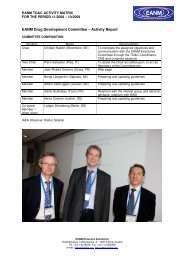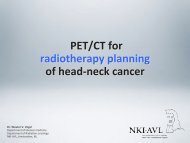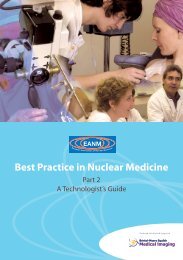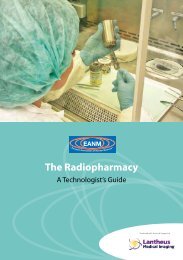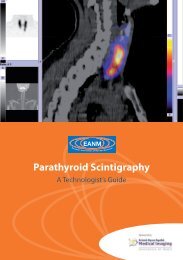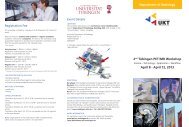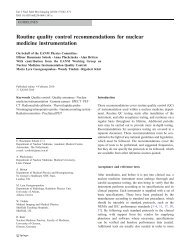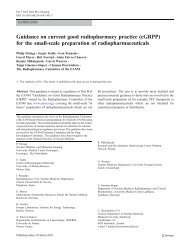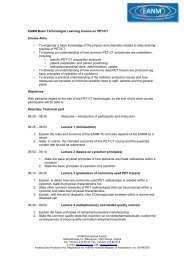Parathyroid Scintigraphy - European Association of Nuclear Medicine
Parathyroid Scintigraphy - European Association of Nuclear Medicine
Parathyroid Scintigraphy - European Association of Nuclear Medicine
Create successful ePaper yourself
Turn your PDF publications into a flip-book with our unique Google optimized e-Paper software.
Introduction<br />
Sue Huggett<br />
The first publication <strong>of</strong> the EANM Technologist<br />
Committee sponsored by Bristol Myers<br />
Squibb in 2004 was a book on myocardial<br />
perfusion imaging for technologists. We<br />
are very grateful that they have sponsored<br />
us again this year to produce this book on<br />
parathyroid imaging, the second book in<br />
what we hope will be a series.<br />
We hope that we have combined the theory<br />
and rationale <strong>of</strong> imaging with the practicalities<br />
<strong>of</strong> patient care and equipment use. I think that<br />
certain things I wrote for the last book bear repeating,<br />
and so I will do so here for the benefit<br />
<strong>of</strong> those for whom this is their first book.<br />
Knowledge <strong>of</strong> imaging theory provides a deeper<br />
understanding <strong>of</strong> the techniques that is satisfying<br />
for the technologist and can form the basis<br />
for wise decision making. It also allows the technologist<br />
to communicate accurate information<br />
to patients, their carers and other staff. Patient<br />
care is always paramount, and being able to<br />
explain why certain foods must be avoided or<br />
why it is necessary to lie in awkward positions<br />
improves compliance as well as satisfaction.<br />
Awareness <strong>of</strong> the rationales for using certain<br />
strategies is needed in order to know when<br />
and how various protocol variations should be<br />
applied, in acquisition or analysis, e.g. for the<br />
patient who cannot lie flat for long enough<br />
for subtraction and may need to be imaged<br />
with another protocol or when we may need<br />
a different filter if the total counts are low.<br />
Protocols will vary between departments,<br />
even within the broader terms <strong>of</strong> the EANM<br />
Guidelines. This booklet is not meant to supplant<br />
these protocols but will hopefully supplement<br />
and explain the rationales behind<br />
them, thereby leading to more thoughtful<br />
working practices.<br />
The authors are indebted to a number <strong>of</strong><br />
sources for information, not least local protocols,<br />
and references have been given where<br />
original authors are identifiable. We apologise<br />
if we have inadvertently used material<br />
for which credit should have been, but was<br />
not, given.<br />
We hope that this booklet will provide helpful<br />
information as and when it is needed so<br />
that the integration <strong>of</strong> theory and practice is<br />
enabled and encouraged.<br />
EANM






